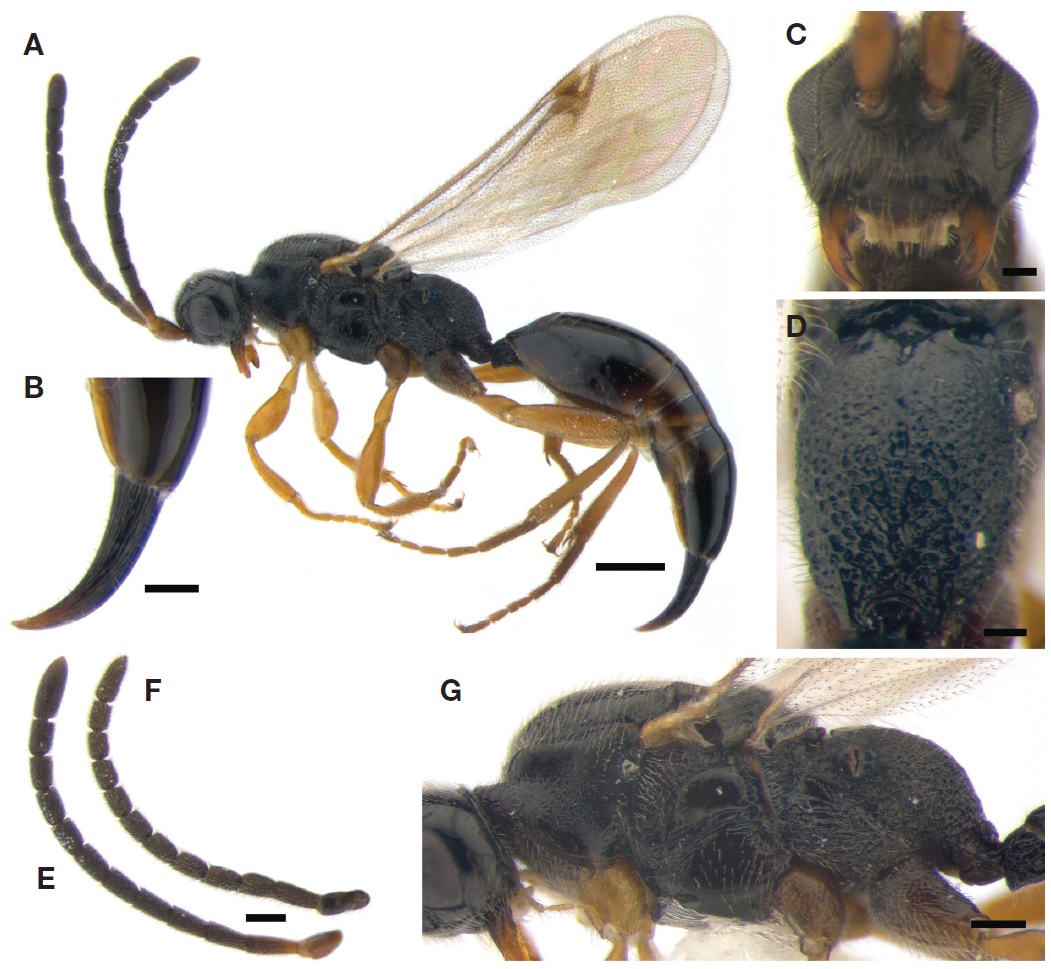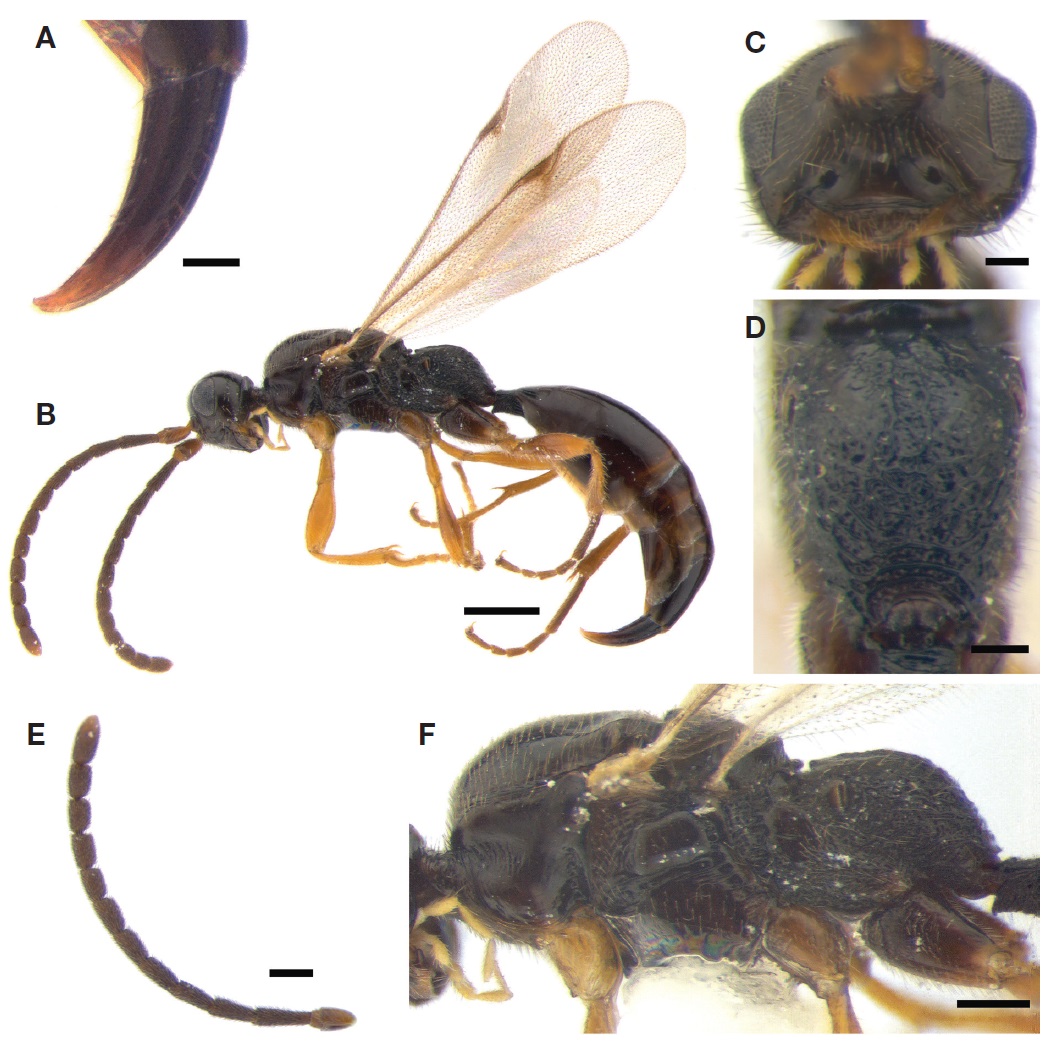



The genus
Here, we report
The terminology used in the present study follows that of Townes and Townes (1981). The images were captured with an Axiocam HRc camera through a Discovery V20 stereomicroscopy (Carl Zeiss, Oberkochen, Germany), then produced with the AxioVision 40AC software (Carl Zeiss). Final photographs were produced in Adobe Photoshop CS6 (Adobe Systems Incorp., San Jose, CA, USA). Abbreviations are as follows: OL, distance between the inner edges of a lateral ocellus and median ocellus; OOL, distance from the outer edge of a lateral ocellus to the compound eye; POL, distance between the inner edges of the two lateral ocelli; MT, malaise trap.
>
Parthenocodrus elongatus
Material examined. Japan: 1♂, Okusawa-suigenchi, Otarushi, Hokkaido, Alt. 197 m, 43°08′57.4″N, 140°57′27.1″E, 24 Jul 2013, Kim CJ; 1♂,
Redescription of female. Body length 5.05-5.54 mm. Forewing length 3.37-3.75 mm.
Head. Head smooth, covered with setae, in dorsal view wider than long (52 : 41), almost equal to width of mesosoma; eye with sparse setae, length of setae on eye 2.00× the width of the last segment of maxillary palpus; POL: 14; OL: 9; OOL: 12; height of head in lateral view equal to its length; mandible bidentate, upper tooth shorter than lower tooth (5 : 6) (Fig. 1C); tentorial pit distinctly visible; antenna shorter than body length (10 : 19); antennal segments in the following proportions (length : width): 17 : 12; 7 : 8; 23 : 9; 20 : 9; 18 : 9; 17 : 9; 16 : 10; 16 : 10; 15 : 10; 15 : 10; 15 : 10; 17 : 10; 31 : 11 (Fig. 1E).
Mesosoma. Mesosoma distinctly longer than its maximum width (75 : 29); lateral side of pronotum smooth and almost without setae, scrobe of pronotum rugose; epomia absent; mesoscutum smooth and covered with setae, notauli absent; mesopleuron with completely horizontal groove, deep foveolate along hind margin; metapleuron rugose, almost without bare area (Fig. 1G); dorsal surface of propodeum dorsally rugose with a shallow longitudinal groove, anterior one-fourth smooth; posterior surface of propodeum rusoge without transverse carinae (Fig. 1D).
Wings. Forewing with costal, subcostal, marginal, postmarginal, radial veins and stigma tubular; radial vein joining costal vein at 38° and descending vertically from the lower corner of the stigma, then curved toward the costal vein; radial cell 0.77× the depth of the stigma.
Metasoma. Metasoma shiny and bare, except syntergite and second sternite with sparse setae; metasoma with short metasomal stalk, its length 0.58× the median depth; dorsal surface of stalk rugose; syntergite basally with median longitudinal groove, 1.25× longer than the length of first thyridium and with four strong additional lateral grooves on each side; ovipositor sheath with distinct longitudinal striations and 0.75× length of hind tibia (Fig. 1B).
Color. Head black, except labrum and mandible brown, palpi yellow; antenna dark brown, except scape, pedicel and basal one-third of first flagellomere yellowish brown; mesosoma and metasoma dark brown to black, except tegula yellowish brown; wings hyaline, covered with brown setae; legs yellowish brown except middle and hind coxae dark brown.
Male. Body length 4.15 mm. Forewing length 3.06-3.29 mm. Similar to female, but antennal segments in following proportions (length : width): 17 : 10; 6 : 8; 21 : 8; 19 : 10; 16: 10; 16 : 10; 16 : 10; 16 : 10; 15 : 10; 16 : 10; 15 : 10; 15 : 10; 24 : 12 (Fig. 1F); sculpture of propodeum reticulate rugose; color of scape, pedicel and fore coxa dark brown.
Host. Elateridae:
Distribution. Japan (new record), South Korea (new record), Transpalaearctic from Europe to Russian Far East.
>
Parthenocodrus puncticauda
Material examined. South Korea: 1♀, Chungcheongbuk-do, Danyang-gun, Danyang-eup, Cheondong-ri, 36°57′25.1″N, 128°36′47.6″E, 12 Jun-22 Jul 2008 (MT), Lee JW; 1♀,
Redescription of female. Body length 4.47-5.56 mm. Forewing length 2.89-3.68 mm.
Head. Head smooth, covered with setae, in dorsal view wider than long (13 : 9), slightly wider than width of mesosoma (13 : 12); eye with sparse setae, length of setae on eye 1.00× the width of the last segment of maxillary palpus; POL: 13; OL: 7; OOL: 14; height of head in lateral view equal to its length; mandible bidentate, upper tooth shorter than the length of the lower tooth (3 : 5) (Fig. 2C); tentorial pit distinctly visible; antenna shorter than body length (26 : 47); antennal segments in following proportions (length : width): 16 : 12; 7 : 8; 28 : 9; 21 : 9; 19 : 9; 18 : 10; 19 : 10; 19 : 10; 18 : 10; 18 : 10; 18 : 10; 17 : 10; 27 : 10 (Fig. 2E).
Mesosoma. Mesosoma distinctly longer than its maximum width (77 : 27); lateral side of pronotum smooth and almost without setae, scrobe of pronotum finely wrinkled; epomia absent; mesoscutum smooth and covered with setae, notauli absent; mesopleuron with completely horizontal groove, deep foveolate along hind margin; metapleuron rugose, with small bare area in upper part (Fig. 2F); dorsal surface of propodeum dorsally rugose with a shallow longitudinal groove, anterior one-fourth smooth; posterior surface of propodeum rusoge with several transverse carinae (Fig. 2D).
Wings. Forewing with costal, subcostal, marginal, postmarginal, radial veins and stigma tubular; radial vein joining costal vein at 42° and descending vertically from the lower corner of the stigma, then curved toward the costal vein; radial cell 0.71× the depth of the stigma.
Metasoma. Metasoma shiny and bare, except syntergite and second sternite with sparse setae; metasoma with short metasomal stalk, its length 0.79× the median depth; dorsal surface of stalk rugose; syntergite basally with median longitudinal groove, 1.57× longer than length of first thyridium and with four strong additional lateral grooves on each side; ovipositor sheath without distinct longitudinal striations and 0.55× the length of the hind tibia (Fig. 2A).
Color. Head black except labrum and mandible brown, palpi yellow; antenna dark brown, except scape, pedicel brown; mesosoma and metasoma dark brown to black, except tegula brown; wings hyaline, covered with brown setae; legs brown except basal half of hind coxa dark brown.
Host. Unknown.
Distribution. South Korea (new record), Russian Far East.

